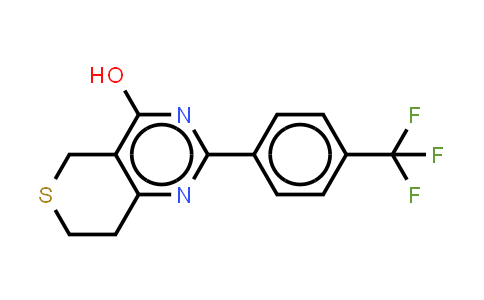
XAV-939 NLT 98%
Product Number : MC546269
CAS Number : 284028-89-3
Molecular Formula : C14H11F3N2OS | Molecular Weight : 312.31
Quote Request| Purity | NLT 98% |
|---|---|
| Storage | at 20ºC 2 years |
| MolCore specializes in manufacturing high-purity CAS No.284028-89-3, XAV-939 with the molecular formula C14H11F3N2OS and molecular weight 312.31 delivering critical API intermediates for global pharmaceutical and research industries, certified under ISO quality systems. | |
* The above information is for reference only.
| Chemical Name | XAV-939 |
|---|---|
| CAS Number | 284028-89-3 |
| MDL Number | MFCD00106866 |
| Molecular Formula | C14H11F3N2OS |
| Molecular Weight | 312.31 |
XAV-939 is a potent tankyrase inhibitor that targets Wnt/β-catenin signaling. XAV-939 stabilizes axin by inhibiting tankyrase 1 and tankyrase 2 (IC50s of 5 and 2 nM, respectively), thereby stimulating β-catenin degradation. XAV939 binds tightly to the catalytic (PARP) domains of TNKS1 and TNKS2 (Kds of 99 and 93 nM, respectively)[1]. IC50 & Target: IC50: 5 nM (TNKS1), 2 nM (TNKS2)[6] In Vitro: XAV939 also binds to recombinant PARP1, although with a significantly lower binding affinity (Kd=1.2 μM). XAV939 (1 μM) strongly inhibis STF activity in SW480 cells, Wnt3a-stimulated STF activity in HEK293 cells, but does not affect CRE, NF-κB or TGF-β luciferase reporters. XAV939 regulates axin levels through tankyrase inhibition in HEK293 cell[1]. XAV939 (0.5 μM, 1.0 μM) reduces DNA-PKcs protein levels 50% of the relative DMSO control in human lymphoblasts[2]. XAV939 induces a second wave of pro-cardiomyocyte gene expression as shown by increased Mesp1 and Isl1expression 2 to 4 days after Wnt inhibition, and by increased Nkx2.5 expression 4 to 6 days after XAV939 addition[3]. XAV-939 (10 nM) has a suppressive effect on elevated MMP-13 levels in both IL-1β-induced SW 1353 cells[4]. In Vivo: XAV-939 (3 mL, 10 nM) has a suppressive effect on elevated MMP-13 levels in the rat OA model[4]. XAV-939 (1 mg/mL, i.p.) ameliorates the psoriasiform skin disease induced by IMQ. XAV-939 results in a significant decrease in the IMQ-induced epidermal hyperplasia (indicated by acanthosis) and dermal inflammatory infiltrates in mice[5].
© Copyright 2015-2025 Hangzhou MolCore BioPharmatech Co.,Ltd. All rights reserved.
